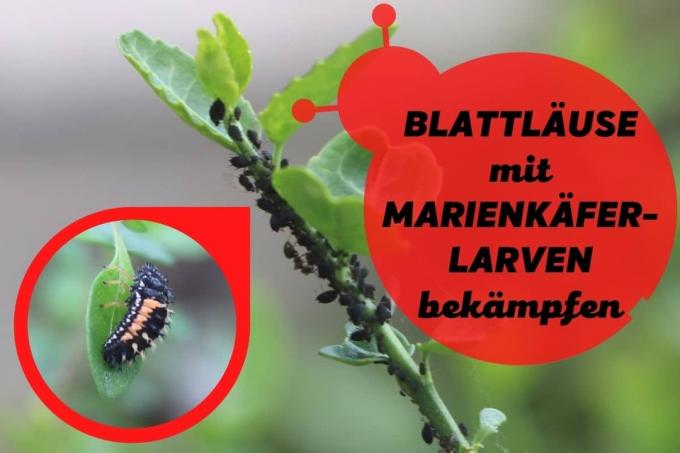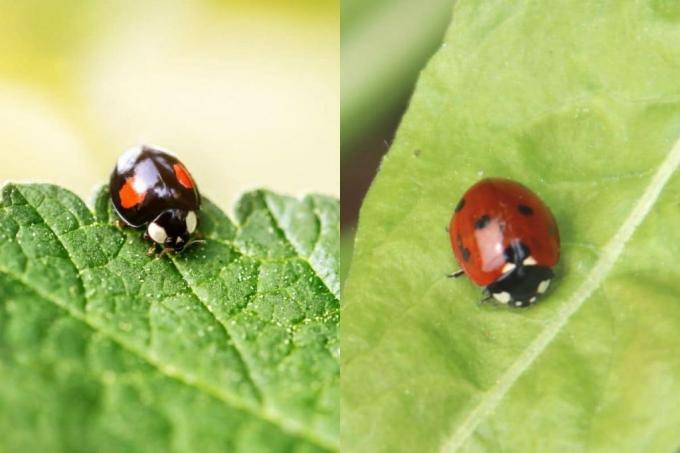
table of contents
- Insert ladybird larvae
- Different types of ladybugs
- Resettle ladybugs
- Winter shelter
- frequently asked Questions
Ladybugs are welcome guests in the garden. And not only because they also remind you of your own childhood. They are also the aphids' greatest enemies. How to successfully use ladybug larvae against lice.
In a nutshell
- Ladybirds predators of aphids and other garden pests
- a single ladybug eats about a hundred aphids a day
- Females prefer to lay on heavily infested plants
- Ladybird larvae eat around 500 aphids until pupation
- Larvae are available in well-stocked specialist shops as well as in internet shops, settlement in your own garden is possible at any time if required
Insert ladybird larvae
If there are few or no ladybugs in your own garden, then it makes sense to buy or order larvae. These are offered in stores by specialized providers and can be helpful against pests:
- Put at least two larvae on each branch
- also use two larvae in aphid colony
- Females lay their eggs directly on aphids
- Carefully place on leaves with a brush
- or sprinkle with carrier material on leaves
- Packaging usually indicates the minimum number of larvae
- immobile larvae are not inevitably dead
- when molting, larvae are rigid
- Dolls are generally immobile
Note: If there are already pupae in the purchased tin of ladybird larvae or if the larvae are rigid, then you should not move them, but leave them in the tin. Larvae that move again may be removed, the pupae should be left in the can until they hatch.
Different types of ladybugs
In the local latitudes, two different species are particularly suitable for controlling aphids:

Two-spot ladybird (Adalia bipunctata)
- these larvae are available in stores
- targeted use is recommended, especially in the greenhouse
- adult beetles do not migrate here
Seven-spotted ladybird (Coccinella septempunctata)
- occurs most frequently in the wild
- attract and settle
Note: Ants also like the aphids, they milk them. A meeting of ants and ladybird larvae and also the adult beetles is not advisable. Therefore, you should put an ant barrier here.
Resettle ladybugs
When ladybird larvae have been ordered and released in the garden, it is then essential to provide the adult beetles with the right habitat. Because if this is not cheap, the adult beetles migrate and settle elsewhere:
- Use ladybird larvae directly on infested plants
- find enough here food
- will pupate here
- hatched beetles also find food directly
- Fennel pollen (Foeniculum vulgare)
- or dill (Anethum graveolens) provide further food
- also chives (Allium schoenoprasum)
- Dandelion (Taraxacum officinale)
- Marigolds (Calendula officinalis)
- Create a natural garden and winter shelter

Tip: If you want the ladybugs to settle and take action against the pesky pests, then you should definitely not actively control the aphids by other means. Because the beetles do not tolerate insecticides or household remedies and they pull away.
Winter shelter
If you want to settle the ladybirds released in the garden so that they can also fight the aphids in the next year, you should also find a suitable shelter for the winter Offer:
- Do not clean up the beds completely
- Leave pruning of perennial plants
- build small hills
- from wooden logs
- Bark scales or leaves are also suitable
- the adult beetles hide here
Tip: If you can encourage ladybugs to hibernate in your garden, then the aphids have no chance of spreading next spring.
frequently asked Questions
No, there are many different types, with the red seven or two dot being the best known. But there are also other basic colors such as orange or yellow. Here, too, the number of points is different, from one to 15 points, everything is included.
Ladybirds cannot tell their age from the dots on their backs. Because the points are there immediately after hatching, depending on which species it is. There are also species such as the native yellow sixteen-spot ladybird (Tytthaspis sedecimpunctata), which does not feed on aphids but on the mildew fungus. Therefore, when choosing the type of ladybird larvae, one must also pay attention to the desired area of application.
If you leave a natural environment for the ladybugs, then you don't have to worry about that the pests migrate from a beneficial meadow to cultivated plants and, for example, their fruit trees infested. Because naturally a balance between beneficial insects and pests develops quickly, in which the pests are always kept below a damage threshold.
If you have a very large infestation, you can also do the first thing with chemicals before releasing the ladybird larvae. However, you must note that the insecticide must be completely dry. Otherwise, it should be noted that while the larvae are sitting near the aphid colonies and about three to five weeks after exposure, no chemical agents should be used.
Unfortunately, this cannot be assumed. Dead larvae may already be in the can. Even with the later pupation, a lot can go wrong, so that they die and no ladybugs hatch. However, this is a completely natural process, as the females lay more and more eggs than later actually develop into adult beetles.
